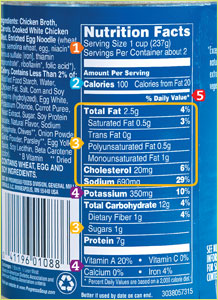Ninety-five percent of adults have read food labels at some point, and about 51 percent use food labels regularly to make food choices, according to a Wall Street Journal Online/Harris Interactive poll. But research suggests that many of us may not be reading them correctly. Here's a look at a label.
![]()
This section explains what is considered a serving and how many servings are in the package. The serving size for this product is 1 cup, but there are 2 servings in the can. So if you eat the whole can, you'll eat 2 servings, and will need to multiply all the nutrition information below (for example, fat, calories, protein) by 2.
![]()
Note the number of calories per serving (remember that's per serving, not per package) and the number of calories from fat.
![]()
Eating too much of these nutrients can be harmful to your health. Avoid any products with trans fats, and take in as little saturated fat, cholesterol, sodium, and sugar as possible. Most of us eat much more of these than we need..
![]()
These nutrients are an important part of a healthy diet.
![]()
On the nutrition label, % Daily Values are based on a 2,000-calorie diet. You may need more calories or fewer than that, and, as a result, more or less of the nutrients listed. Here is an easy guide for interpreting % Daily Values:
5% Daily Value or less – Contains a low amount of the nutrient
This is good for nutrients you want to limit and not good for nutrients you want to eat more of.
20% Daily Value or more – Contains a high amount of the nutrient
This is good for nutrients you want to eat more of and not good for nutrients you want to limit.





